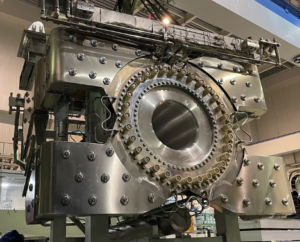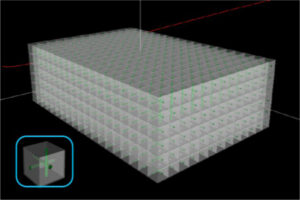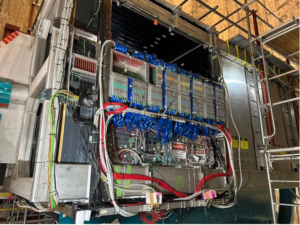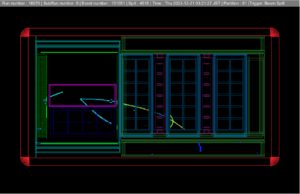Large Upgrade of T2K Experiment
The T2K experiment, in which Osaka Metropolitan University is actively participating, has resumed with significantly improved performance due to enhancements in the neutrino production equipment and extensive upgrades to the ND280 near detector. We would like to introduce these performance improvements.
First, however, it is necessary to discuss the power upgrade of the J-PARC accelerator. The success of the T2K experiment is heavily dependent on the power upgrade of the J-PARC accelerator. As shown in Figure 1, the beam power of the J-PARC main ring, which accelerates protons to 30 GeV, has been continuously increasing since the start of the T2K experiment. In fiscal year 2022, the beam supply was temporarily suspended for upgrades, successfully achieving a significant increase in beam power. This was achieved by using a large capacity capacitor in the power supply for the Main Ring’s main electromagnets and by increasing the repetition frequency of acceleration from 2.48 seconds to 1.36 seconds, enabling more protons to be sent to the neutrino beamline. As a result, the Main Ring’s beam power increased from 500 kW in fiscal year 2021 to 760 kW on December 25, 2023, surpassing the T2K experiment’s design strength of 750 kW. This equates to 2.16×1014 protons per pulse, the highest value in the world for a proton accelerator using a synchrotron method. This achievement was the best Christmas present for the T2K experiment. The first beam time of this fiscal year was conducted from June 7 to June 28, further increasing the beam power to achieve stable continuous operation at 800 kW. In the future, aiming for the Hyper-Kamiokande experiment, the goal is to achieve 1.3 MW operation, which is 1.6 times the current power, by fiscal year 2028.
Next, regarding the enhancement of the neutrino production equipment, the pulse current flowing through the Horn Magnet, which focuses the pions that are the source of neutrinos, was increased from 250 kA to 320 kA. For details on the principle of the Horn Magnet, please refer to the High Energy Physics Research Laboratory News dated January 20, 2015. By increasing the current flowing through the Horn Magnet, the collection efficiency of pions produced in the graphite target improved, increasing the neutrino beam intensity by 10%. Due to the increased current, the Joule heat generated in the conductor also increased, reaching 25 kJ per pulse. To address this, the cooling capacity has been significantly enhanced. Figure 2 shows a photograph of the new horn magnet with these improvements.
On the other hand, three new detectors have been introduced in the T2K experiment’s ND280 near detector. The first is the “SuperFGD,” installed in the central part of the area where the PØD (pi-zero detector), which was used to measure the cross-section of π0 production by neutrino reactions and was the main background during the discovery of νe appearance events, was removed (Figure 3). This consists of approximately 2 million 1 cm3 plastic scintillator cubes with holes in the x, y, and z directions, through which about 56,000 wavelength-shifting optical fibers are passed, allowing for high-resolution 3D tracking of charged particles through MPPC photodetectors attached to all fiber ends. The second detector is the “High-Angle TPC,” installed above and below the SuperFGD. This detector uses improved MicroMegas for the anode, boasting a positional accuracy of 600–800 μm compared to the 600–1600 μm accuracy of the vertical TPCs previously used in ND280. The dE/dx measurement accuracy, used for particle identification, is also below 10%. This detector allows for precise momentum measurement of particles emitted at large angles, which ND280 previously struggled with. The third detector is the “Time-Of-Flight” surrounding the two new detectors. Made of plastic scintillator, it has a timing accuracy of 100–130 ps, enabling the identification of whether passing particles are produced within the detector or are background cosmic rays from outside. These detectors were installed in autumn 2023 (Figure 4), followed by commissioning and calibration. Neutrino beam observation started in December 2023, successfully capturing candidate events of neutrino reactions as shown in Figure 3.
| As mentioned in the High Energy Physics Research Laboratory News dated March 13, 2020, a significant CP symmetry violation is necessary for the current matter-dominated universe to exist. The T2K experiment has rejected many of the possible values of the CP phase angle δCP, which indicates CP symmetry violation in neutrinos, bringing us closer to discovering CP symmetry violation. Using the upgraded detection equipment, we will continue our research. |





